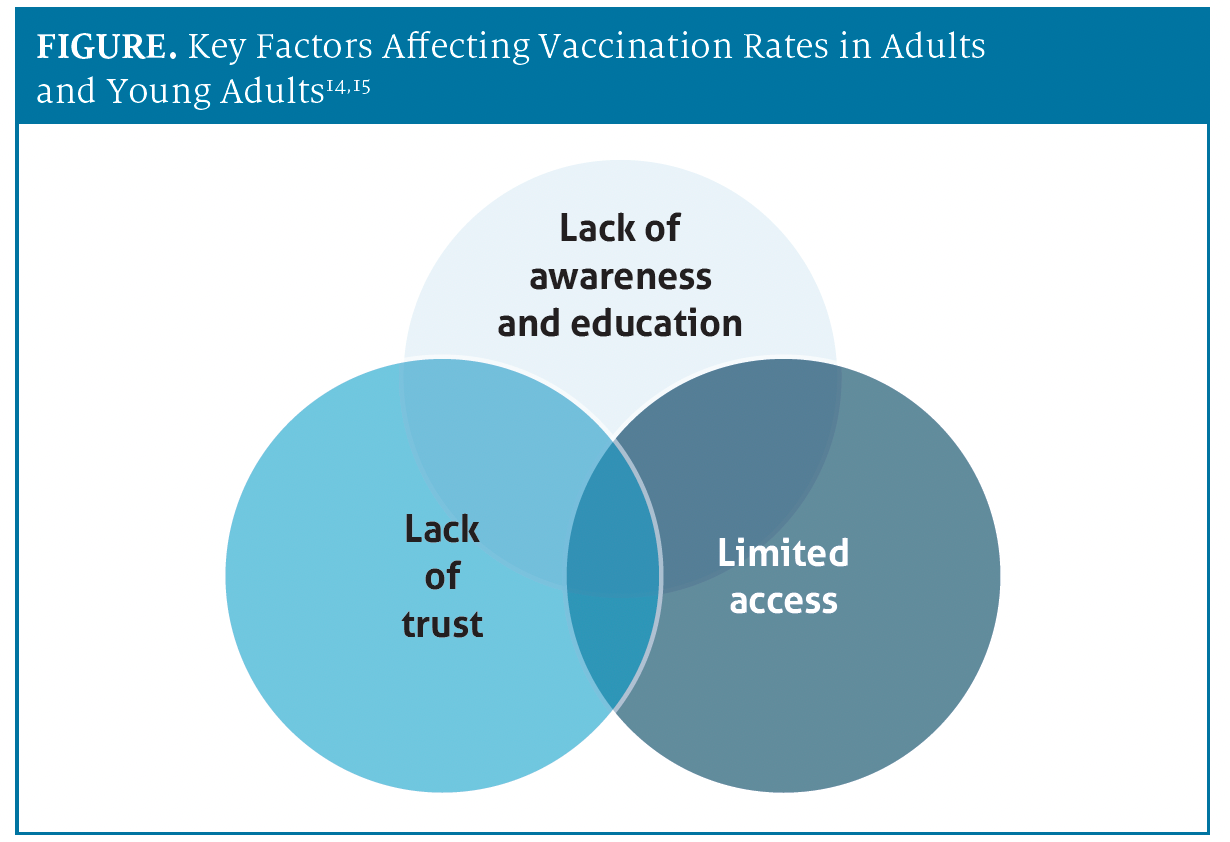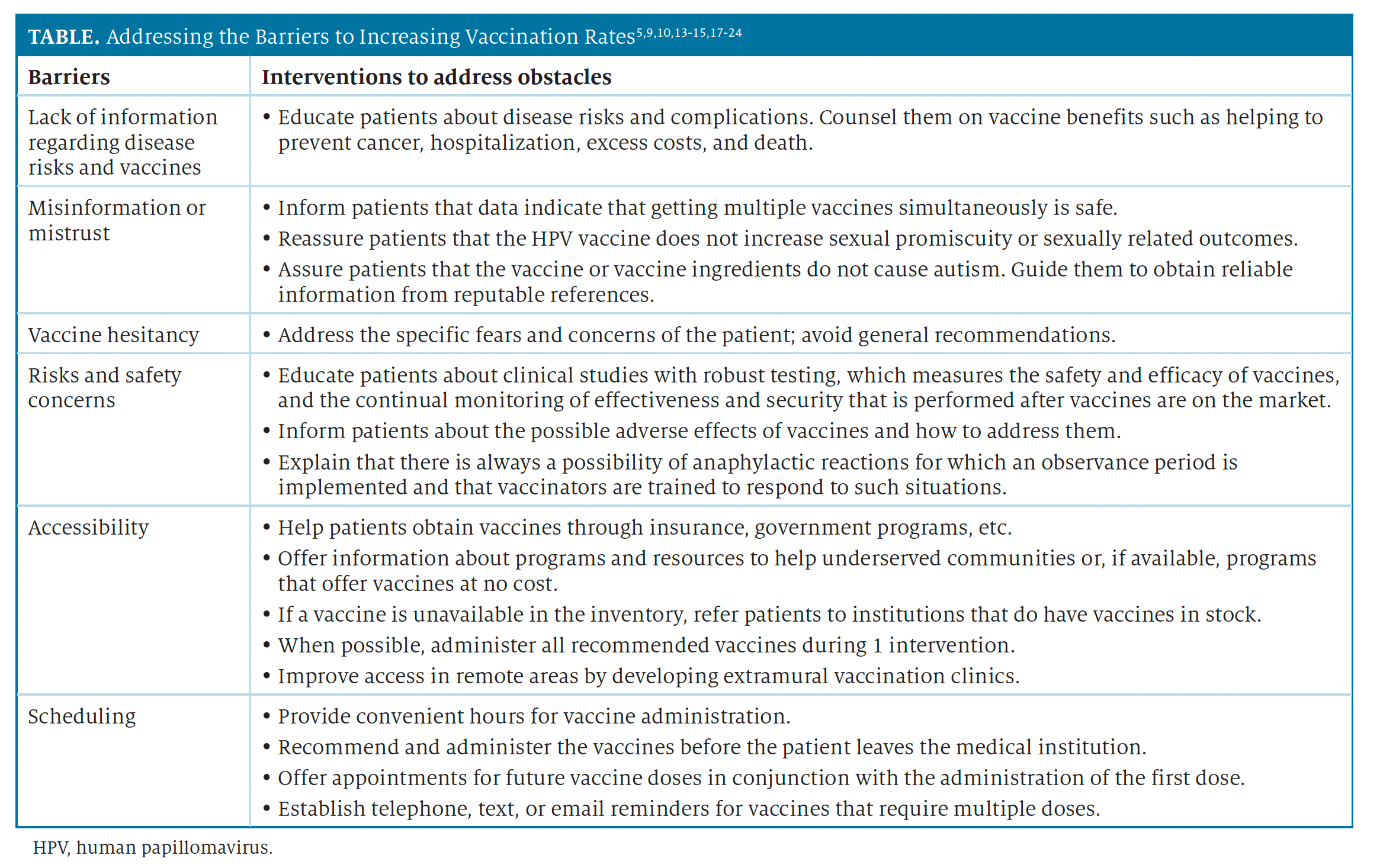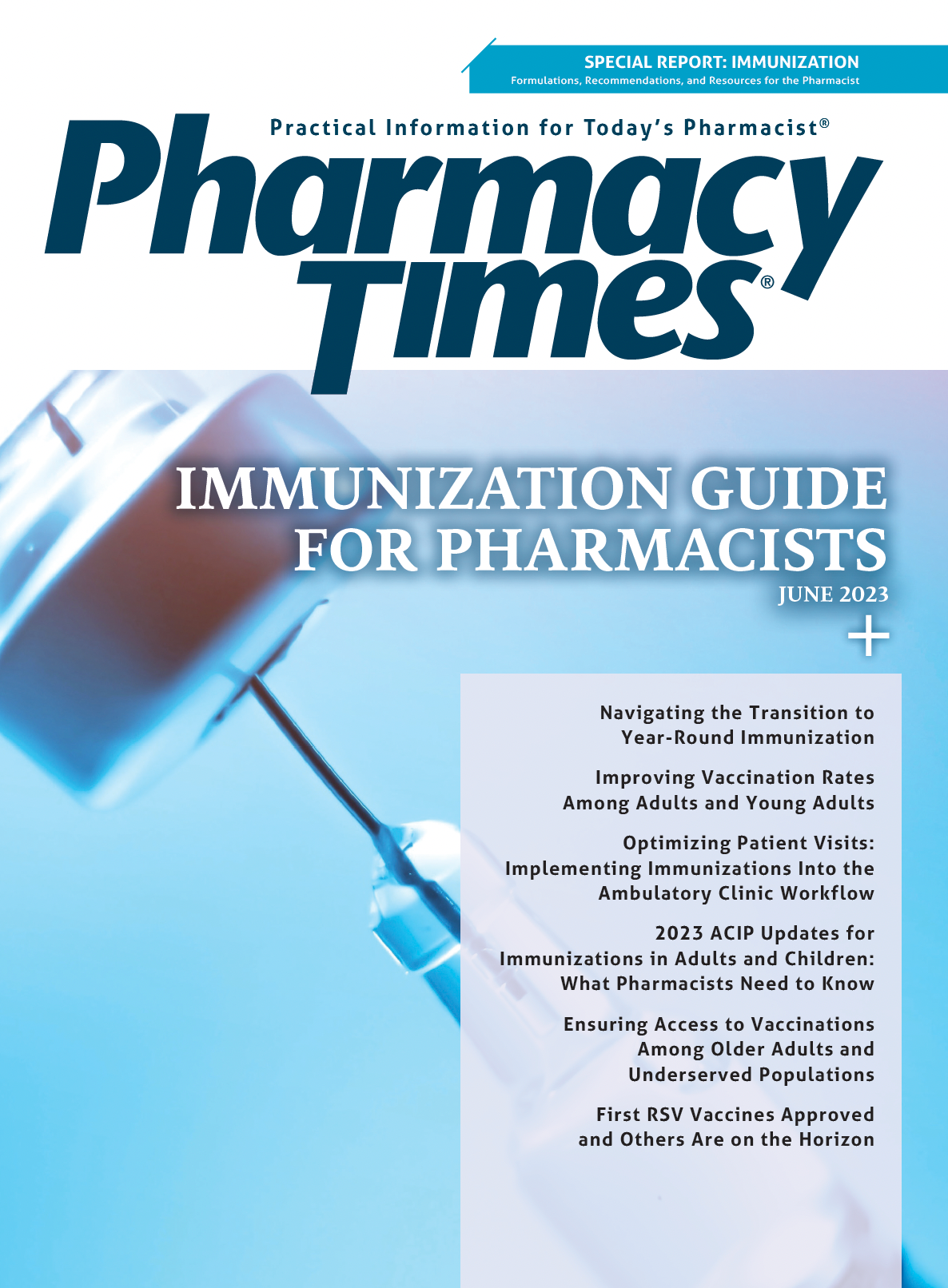Publication
Article
Supplements
Improving Vaccination Rates Among Adults and Young Adults
Myths, fears, distrust, and misinformation on immunizations can keep patients from benefiting from their protective effects.
The health crisis generated by the COVID-19 pandemic during the past 3 years has undoubtedly confirmed the importance of immunization as an essential tool to protect public health worldwide. For decades, vaccines have proven to be effective in preventing diseases such as polio, hepatitis B, human papillomavirus (HPV), tetanus, and pneumococcal disease, among others, in children and adults. Despite the documented efficacy of vaccines, suboptimal immunization rates arecontinuously reported in adults and young adults, which raises concerns about the immunologic vulnerability of the population to vaccine-preventable diseases (VPDs).1,2
candy1812 - stock.adobe.com

Findings from the National Health Interview Survey published in 2021 confirmed low immunization rates among US adults with substantial discrepancies between racial and ethnic groups.1 Recent data from the US Government Accountability Office also indicated that vaccination rates among Black or African American and Hispanic or Latino adults were at least 13% below White adults for the influenza, shingles, pneumococcal, and tetanus vaccines.2 Because low vaccination rates are considered to be one of the major contributors to outbreaks and dissemination of such diseases, immunization of individuals of all ages remains a key factor in achieving and maintaining the herd immunity needed for long-term disease control.3 Due to the importance of vaccines in disease prevention, the vaccination objective ofHealthy People 2030, a program sponsoredby the US Department of Health and Human Services, focuses on the increase of vaccinationrates among the US population, particularly among adults and young adults.4
Several factors have been identified as contributors for vaccine refusal among patients and caregivers. When addressing vaccine refusals, it is important to remember that this behavior is not exclusive of the adult population. Adolescents have their own ideas and thoughts regarding their well-being and whether to receive recommended immunizations.5 Increasing their desire and proactivity to obtain the recommended vaccines may improve vaccination rates among this population.
For many years, researchers have debated how to overcome the issue of parental refusal of vaccines because parents or legal guardians make the final health care decisions regarding the immunization status of their children. One of the most controversial issues regarding adolescent immunization in the United States is the administration and completion of the HPV vaccine series.6,7 According to the CDC, 61.7% of US adolescents (aged 13-17 years) were up-to-date on the HPV vaccination in 2021.8 Among the reported challenges with initiating or completing the doses for the HPV vaccination series include lack of information about the disease and the benefits of the vaccine, the belief that a child is too young to get vaccinated for HPV, apprehension about the vaccine’s effect on sexual behavior, lack of awareness about the risk of HPV infection (particularly among boys), concerns about vaccine safety and novelty, lack of insurance or cost of the HPV vaccine, accessibility, and the absence of a health care professional’s recommendation for the HPV vaccine.6,7,9 Other barriers to obtaining routine adolescent vaccinations include difficulty scheduling appointments for vaccinations and lack of awareness about the purpose of some vaccinations, especially if they are not required for school entry.9
The COVID-19 pandemic also posed a challenge to obtaining routine vaccines. Initial measures to prevent the spread of the virus (eg, lockdowns, quarantines), patients refraining from seeking health care services due to fear of being exposed to the virus, and providers withholding routine care to focus on addressing the pandemic all played a role in decreased vaccination rates.10,11 According to the World Health Organization (WHO), millions of children around the world missed recommended vaccines in 2021, which contributed to the most considerable sustained reduction in childhood vaccinations in the past 30 years.12
Despite the solid evidence about the importance of vaccines in preventing morbidity and death from VPDs, achieving optimal immunization rates remains a challenge due to vaccine refusal.13,14 There are myriad, complex reasons for vaccine refusal. These include the patient’s lack of confidence (eg, lack oftrust in the efficacy and safety of vaccines, the health care system, health care professionals, researchers, pharmaceutical companies, and governmental agencies that advocate for vaccinations), complacency (perceived low risk of acquiring VPDs or lack of awareness about the actual dangers of VPDs), and lack of convenience (eg, decreased access, availability, and affordability; and low health literacy) (Figure).14,15 The WHO Strategic Advisory Group of Experts on Immunization defines “vaccine hesitancy” as a delay or rejection of a vaccine despite its availability; hesitancy can be affected by specific vaccines, places, times, and populations, as well as other factors.14
Image From Pharmacy Times® Immunization Guide for Pharmacists June 2023

Recently, vaccine hesitancy was observed during the COVID-19 pandemic; common reasons for not taking the COVID-19 vaccine included apprehension about adverse events due to the short development and manufacture time of the vaccine, efficacy and safety concerns, mistrust of government, and lack of knowledge.15 The lack of knowledge surrounding COVID-19 vaccines encompasses several crucial aspects. These include the intricate layered model utilized in the production and manufacturing of the COVID-19 vaccine, understanding the mechanism of mRNA vaccines, unfamiliarity with the specific attributes of COVID-19 vaccines, and inadequate knowledge regarding the virus itself and its implications for health.15
Interventions to Improve Vaccination Rates
Education is perhaps the most important tool to reduce barriers and increase vaccination rates among individuals and communities.13,15 Education can be provided through oral or written materials. Engaging in an open discussion, listening to patients to understand their concerns or fears, building patient–provider trust, avoiding a judgmental attitude, and treating patient concerns or fears as valid are all vital approaches when interacting with vaccine-hesitant individuals. Pharmacists should address patients' concerns, provide targeted education, and ensure that patients feel they are heard and that their feelings are valued. Information that may be given includes explaining how vaccines work and dispelling incorrect or misleading information. Information should be accurate, current, and transparent.15
Pharmacists and team members can improve vaccination rates by serving as educators, facilitators, and immunizers.16-18 Frequent training, educational sessions, or discussions may increase vaccine confidence and aid in keeping every member of the team up-to-date with current vaccine recommendations. Pharmacists should be able to identify candidates for vaccines based on age, comorbid conditions, risk factors, and pregnancy status. Identification of patients can be completed via patient–pharmacy team or patient-pharmacist encounters, and medication andvaccine history evaluations. In addition, as part of the pharmacy workflow, team members can consistently ask every patient about their vaccine history and offer a recommended vaccination at each visit. Pharmacists can develop programs to improve vaccine awareness in special populations, such as offering tetanus, diphtheria, and acellular pertussis (Tdap) and influenza vaccines to pregnant patients or ensuring that patients with diabetes are up-to-date with pneumococcal, hepatitis B, influenza, and age-recommended vaccines. For young adults and adolescents, parents may be approached and offered information about the VPDs that may affect their children, complications associated with the diseases, and the protection that vaccines provide.5,9,10 Pharmacists can then offer a solid recommendation for the HPV, Tdap, and meningococcal vaccines. The Table presents several strategies to overcome vaccine hesitancy and increase vaccination rates.5,9,10,13-15,17-24
Image From Pharmacy Times® Immunization Guide for Pharmacists June 2023

The Centers for Medicare & Medicaid Services, in concert with the National Committee for Quality Assurance (NCQA), compile the Healthcare Effectiveness Data and Information Set (HEDIS) scores.25 These scores measure outcomes related to significant public health issues, such as immunization data,25-27 and are important tools in assessing vaccine coverage and immunization rates among the US population The data are used to identify performance gaps or areas of improvement, establish initiatives or goals to improve outcomes, and monitor accomplishments of in-progress initiatives.25 The NCQA Immunizations for Adolescents (IMA) measure evaluates patients 13 years of age who have received 1 dose of meningococcal vaccine, 1 Tdap vaccine, and the complete HPV vaccine series by their thirteenth birthday.26 In comparison, the NCQA Adult Immunization Status score measures the percentage of patients 19 years of age and older who are up-to-date on recommended routine vaccines for influenza, tetanus and diphtheria (Td) or Tdap, herpes zoster, and pneumococcus.27 Recommendations to improve HEDIS immunization scores include reviewing patients’ immunization records before or during every encounter and administering needed vaccines, providing written information about VPDs and vaccine advantages, offering reminder messages (email, text, calls) about immunizations that are due, and training personnel to schedule patients’ visits within the recommended time frame for the particular vaccine. For patients younger than 18 years, effective strategies to improve IMA scores are as follows: provide vaccine recommendations to parents or guardians and inform them of common misconceptions about vaccinations; tell them that the HPV vaccine is a 2- or 3-shot series28 and explain that it is important to complete the series for their child’s protection; and finally, administer the HPV vaccine at the same time as other vaccines.
Conclusion
Vaccines are one the most powerful instruments for public health protection because they are instrumental in disease prevention. However, myths, fears, distrust, and misinformation can keep patients from benefiting from their protective effects. Low vaccination rates can lead to outbreaks and dissemination of preventable diseases, including the ones considered previously eradicated. As pharmacists, one of our essential roles is to provide preventive care targeted to protect individual patients and communities; this can be accomplished by supplying valuable information about the importance of immunizations. Encouraging patients to become immunized, facilitating immunization delivery, administering vaccines, and developing strategies targeted to increase vaccine uptake in all populations, particularly adults and young adults, are fundamental to this effort.
About The Authors
Frances M. Colón-Pratts, PharmD, CDCES, is a clinical assistant professor at the Barry and Judy Silverman College of Pharmacy of Nova Southeastern University, Puerto Rico campus, and an ambulatory clinical pharmacist.
Blanca I. Ortiz, PharmD, BSPh, is the assistant dean of the Barry and Judy Silverman College of Pharmacy of Nova Southeastern University, Puerto Rico campus, and a community practicing pharmacist.
References
1. Lu PJ, Hung MC, Srivastav A, et al. Surveillance of vaccination coverage among adult populations—United States, 2018. MMWR Surveill Summ. 2021;70(3):1-26. doi:10.15585/mmwr.ss7003a1
2. United States Government Accountability Office. Routine vaccinations: adult rates vary by vaccine type and other factors. GAO; 2022. Accessed April 28, 2023. https://www.gao.gov/assets/gao-22-105334.pdf
3. Ashby B, Best A. Herd immunity. Curr Biol. 2021;31(4):R174-R177. doi:10.1016/j.cub.2021.01.006
4. Office of Disease Prevention and Health Promotion. Healthy People 2030: vaccination. US Department of Health and Human Services. Accessed April 28, 2023. https://health.gov/healthypeople/objectives-and-data/browse-objectives/vaccination
5. Cadeddu C, Castagna C, Sapienza M, et al. Understanding the determinants of vaccine hesitancy and vaccine confidence among adolescents: a systematic review. Hum Vaccin Immunother. 2021;17(11):4470-4486. doi:10.1080/21645515.2021.1961466
6. Holman DM, Benard V, Roland KB, Watson M, Liddon N, Stokley S. Barriers to human papillomavirus vaccination among US adolescents: a systematic review of the literature. JAMA Pediatr. 2014;168(1):76-82. doi:10.1001/jamapediatrics.2013.2752
7. Berenson AB. An update on barriers to adolescent human papillomavirus vaccination in the USA. Expert Rev Vaccines. 2015;14(10):1377-1384. doi:10.1586/14760584.2015.1078240
8. Pingali C, Yankey D, Elam-Evans LD, et al. National vaccination coverage among adolescents aged 13-17 years—National Immunization Survey-Teen, United States, 2021. Morb Mortal Wkly Rep. 2022;71(35):1101-1108. doi:10.15585/mmwr.mm7135a1
9. Vielot NA, Islam JY, Sanusi B, et al. Overcoming barriers to adolescent vaccination: perspectives from vaccine providers in North Carolina. Women Health. 2020;60(10):1129-1140. doi:10.1080/03630242.2020.1802639
10. Olusanya OA, Bednarczyk RA, Davis RL, Shaban-Nejad A. Addressing parental vaccine hesitancy and other barriers to childhood/adolescent vaccination uptake during the coronavirus (COVID-19) pandemic. Front Immunol. 2021;12:663074. doi:10.3389/fimmu.2021.663074
11. SeyedAlinaghi S, Karimi A, Mojdeganlou H, et al. Impact of COVID-19 pandemic on routine vaccination coverage of children and adolescents: a systematic review. Health Sci Rep. 2022;5(2):e00516. Published February 18, 2022. doi:10.1002/hsr2.516
12. COVID-19 pandemic fuels largest continued backslide in vaccinations in three decades. World Health Organization. July 15, 2022. Accessed April 30, 2023. https://www.who.int/news/item/15-07-2022-covid-19-pandemic-fuels-largest-continued-backslide-invaccinations-in-three-decades
13. Kolobova I, Nyaku MK, Karakusevic A, Bridge D, Fotheringham I, O’Brien M. Vaccine uptake and barriers to vaccination among at-risk adult populations in the US. Hum Vaccin Immunother.2022;18(5):2055422. doi:10.1080/21645515.2022.2055422
14. MacDonald NE; SAGE Working Group on Vaccine Hesitancy. Vaccine hesitancy: definition, scope and determinants. Vaccine. 2015;33(34):4161-4164. doi:10.1016/j.vaccine.2015.04.036
15. Nawas GT, Zeidan RS, Edwards CA, El-Desoky RH. Barriers to COVID-19 vaccines and strategies to improve acceptability and uptake. J Pharm Pract. 2022;8971900221081621. doi:10.1177/08971900221081621
16. Isenor JE, Edwards NT, Alia TA, et al. Impact of pharmacists as immunizers on vaccination rates: a systematic review and metaanalysis. Vaccine. 2016;34(47):5708-5723. doi:10.1016/j.vaccine.2016.08.085
17. Guidelines for pharmacy-based immunization advocacy and administration. American Pharmacists Association. January 26, 2019. Accessed May 10, 2023. https://aphanet.pharmacist.com/sites/default/files/files/Guidelines_for_Pharmacy_Based_IMZ_Advocacy_Approved_Jan_26_2019.pdf
18. The essential role of community pharmacies in expanding access to vaccines. The American Journal of Managed Care. July 26, 2018. Accessed May 10, 2023. https://www.ajmc.com/view/essential-role-community-pharmacies-expanding-access-vaccines
19. Michie S. Encouraging vaccine uptake: lessons from behavioural science. Nat Rev Immunol. 2022;22(9):527-528. doi:10.1038/s41577-022-00769-2
20. Vaccine safety: multiple vaccines at once. CDC. Updated August 14, 2020. Accessed May 1, 2023. https://www.cdc.gov/vaccinesafety/concerns/multiple-vaccines-immunity.html
21. Leidner AJ, Chesson HW, Talih M. HPV vaccine status and sexual behavior among young sexually-active women in the US: evidence from the National Health and Nutrition Examination Survey, 2007-2014. Health Econ Policy Law. 2020;15(4):477-495. doi:10.1017/ S1744133119000136
22. Bednarczyk RA. Addressing HPV vaccine myths: practical information for healthcare providers. Hum Vaccin Immunother. 2019;15(7-8):1628-1638. doi:10.1080/21645515.2019.1565267
23. Autism and vaccines. CDC. Updated December 1, 2021. Accessed on May 1, 2023. https://www.cdc.gov/vaccinesafety/concerns/autism.html
24. Preventing and managing adverse reactions. CDC. Updated October 18, 2022. Accessed May 10, 2023. https://www.cdc.gov/vaccines/hcp/acip-recs/general-recs/adverse-reactions.html
25. Healthcare Effectiveness Data and Information Set (HEDIS). Centers for Medicare & Medicaid Services. Updated March 18, 2023. Accessed May 1, 2023. https://www.cms.gov/Medicare/Health-Plans/Special-NeedsPlans/SNP-HEDIS#:~:text=HEDIS%20is%20a%20comprehensive%20set,smoking%2C%20asthma%2C%20and%20diabetes
26. Immunizations for adolescents (IMA). National Committee for Quality Assurance. Accessed May 1, 2023. https://www.ncqa.org/hedis/measures/immunizations-for-adolescents/
27. Adult immunization status (AIS). National Committee for Quality Assurance. Accessed May 1, 2023. https://www.ncqa.org/hedis/measures/adult-immunization-status/
28. Child and adolescent immunization schedule by age. CDC. April 27,2023. Accessed May 10, 2023. https://www.cdc.gov/vaccines/schedules/hcp/imz/child-adolescent.html#note-hpv

Newsletter
Stay informed on drug updates, treatment guidelines, and pharmacy practice trends—subscribe to Pharmacy Times for weekly clinical insights.






